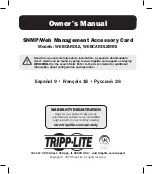
13
4.
Connect the end of the DC power cord to a DC power source, with the wire marked with –
connected to the terminal marked with –48V(–) and the wire marked with + connected to the
terminal marked with RTN (+).
(Optional) Installing transceiver modules
WARNING!
Disconnected optical fibers or transceiver modules might emit invisible laser light. Do not stare into
beams or view directly with optical instruments when the router is operating.
CAUTION:
To avoid transceiver module or port damage, read this guide carefully before installing a transceiver
module.
CAUTION:
•
Be careful not to touch the golden plating on a transceiver module during the installation process.
•
Before installing a transceiver module, remove the optical fibers, if any, from it.
•
Make sure the transceiver module is aligned correctly with the target port before pushing it into
the port.
•
Do not remove the dust plugs from a transceiver module until you are ready to connect optical
fibers to it.
Installing an XFP/QSFP+/QSFP28/SFP28/SFP+/SFP
transceiver module
The installation procedure is similar for XFP, QSFP+, QSFP28, SFP28, SFP+, and SFP transceiver
modules. The following uses an SFP+ transceiver module for illustration.
To install an SFP+ transceiver module:
1.
Wear an ESD wrist strap and make sure it makes good skin contact and is reliably grounded.
For more information, see "
."
2.
Remove the dust plug from the target fiber port.
3.
Unpack the transceiver module.
4.
As shown in
, close the bail latch upward to catch the knob on the top of the
transceiver module. Then correctly orient the transceiver module and align it with the fiber port,
and push it gently into the port until you feel it snap into place.
Transceiver modules and fiber ports have disorientation rejection designs. If you cannot insert a
transceiver module easily into a port, the orientation might be wrong. Remove and reorient the
transceiver module.
In case of limited space, you can gently push against the front face of the transceiver module
instead of the two sides.
5.
If you are not to install an optical fiber, insert a dust plug into the transceiver module bore.
6.
Connect a fiber to the module. For the installation procedure, see "Connecting your router to the
network through optical fibers."
Summary of Contents for CR16000-F
Page 40: ...9 Figure 11 Securing the power cord method one Figure 12 Securing the power cord method two...
Page 47: ...16 Figure 22 Installing an SMB coaxial clock cable...
Page 66: ...5 Figure 5 Removing a common card Figure 6 Removing a card with a locking clip 1 3 2...
Page 76: ...15 Figure 19 Replacing an SMB coaxial clock cable...
Page 89: ...12 Figure 14 Example of a device label...
















































